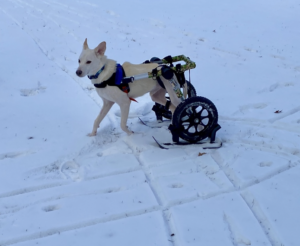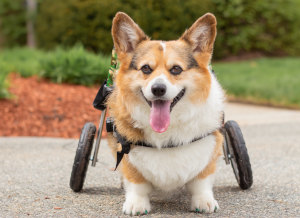The first time a dog owner hears about dog wheelchairs, might because their dog has become paralyzed or is having a hard time getting around. And that can mean a lot of unanswered questions. Here are some of the more common questions that pet parents have about dog wheelchairs and how they work:
Why do dogs have wheelchairs?
There are many different reasons why a dog might need a wheelchair. Typically, a dog needs a wheelchair when it has lost strength in its legs, has difficulty walking unassisted, or is paralyzed. Rear leg paralysis is one of the most common reasons a dog needs a wheelchair.
A dog may need a wheelchair if it is dealing with any of the following conditions:
- Intervertebral Disc Disease (IVDD)
- Degenerative Myelopathy
- Spinal disease
- Severe hip dysplasia
- Cruciate tears or ruptured CCL
- Recovering after a traumatic injury or surgery
- Neurological deficits
- Cerebellar Hypoplasia (CH)
- Rear leg paralysis
- Wobbler’s Disease
- Senior dog dealing with mobility loss
- Hind leg weakness
What size dog can get a wheelchair?
Wheelchairs are available to fit all sized pets, regardless of breed or weight. For example, the Walkin’ Wheels adjustable dog wheelchair will fit dogs as small as two pounds up to large dogs weighing one hundred and eighty pounds.
There are six different Walkin’ Wheels wheelchair sizes:
- Mini wheelchair – for dogs under 2 lbs.
- Small wheelchair – for dogs 11 to 25 lbs.
- Medium wheelchair – 26 to 49 lbs.
- Medium/Large wheelchair – 50 to 69 lbs.
- Large wheelchair – 70 to 180 lbs.
- Corgi wheelchair – a specially made frame, designed to fit the long torso of a Corgi.
The right wheelchair frame size for your pet will be based entirely on their weight.
How do you measure your dog for a wheelchair?
Measure your dog lying down on its side. Most dogs that need a wheelchair cannot stand at their full height when standing. Even the dogs that can support their weight, their back legs may bend and lack the strength to stand correctly. This may mean that their rear leg height measurement is shorter than it should be.

How to measure your dog for a cart:
- Lay down on its side
- Position their back leg in a natural standing position with a slight bend.
- Measure the rear leg, from the crease where the thigh meets the body all the way to the toe pad. This measurement would be the height of your dog’s back leg if they were standing fully.
Can my dog go to the bathroom while using a wheelchair?
A dog can pee and poop while using a wheelchair. Leg rings support the dog’s hind end from underneath, leaving plenty of space in front and behind the dog to defecate cleanly.
Getting a dog into a wheelchair makes it easier for them to relieve themselves. Giving a pet the support to stand upright allows everything to move naturally. Bringing your dog on a walk and showing them all their favorite spots will help encourage them to pee and poop while in their wheelchair.
My dog can still use its back legs. Can it use a wheelchair?
Wheelchairs are intended to help dogs exercise and move their back legs. For a dog that maintains function in its back legs, a wheelchair will help them maintain muscle mass, prevent further atrophy, and help the dog to rebuild leg strength. Using a wheelchair will not discourage your dog from using its back legs. Instead, using a wheelchair will make it easier for your dog to exercise, which may encourage them to walk even more.
How long will it take for my dog to become accustomed to a wheelchair?

Every dog’s experience is a little different, and most dogs will adjust very quickly to using a wheelchair. Most dogs realize very quickly that the wheelchair is helping them, and they immediately notice that they can walk again.
Other dogs may need more time to become accustomed to their cart. Work at your dog’s pace and make it a rewarding experience for them. Lots of praise and plenty of high-reward treats are great to keep on hand as your dog is adjusting to life on wheels. If your dog seems tired or nervous, take them out of the wheelchair and give them a break. Try again in a few hours after your dog has rested a bit. Remember, it’s probably been a while since your dog has been able to walk. The first time they try out their cart, they are getting a workout.
For timid dogs, it may help to leave the wheelchair out in a room they use frequently. This will allow your dog to approach the cart at their own speed, sniff it all over, and get comfortable with it being around. In addition, it can be helpful to reward them every time your dog goes near the wheelchair, this helps to build a positive relationship with their new cart.
Can my dog lie down while using a wheelchair?
Dog wheelchairs are designed support your dog in an upright and standing position. Encouraging canine mobility and exercise. A wheelchair should never collapse on your dog’s back legs.
Some smaller breeds, such as dachshunds or corgis can rest on their front legs with a pillow underneath them for short periods of time. For your wheelchair dog to sleep comfortably, they should be taken out of the wheelchair to rest.
How long can a dog be left in a wheelchair?
How long your dog can stay in their cart will vary for every dog. We recommend speaking to your vet about what’s best for your dog as their age, overall fitness, and their stamina can contribute.
When first adapting to their cart, you should begin with shorter sessions and your dog should always be supervised while in their wheelchair. While dog is first adjusting to their wheelchair, limit their wheelchair time to 10 to 15 minute increments multiple times a day until they build up their endurance. Every dog requires a different amount of daily exercise, and you will find what works best for your dog.
For any questions or concerns please feel free to reach out to us at 778-809-7421 or email us at contact@handicappedpetscanada.com
A special thanks to Walkin’ Pets and their blog providing this information!

